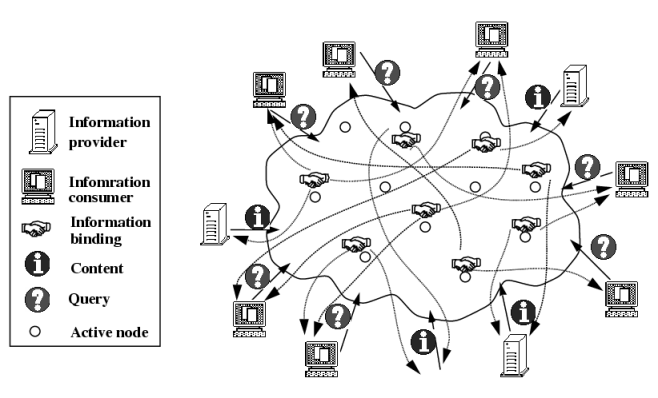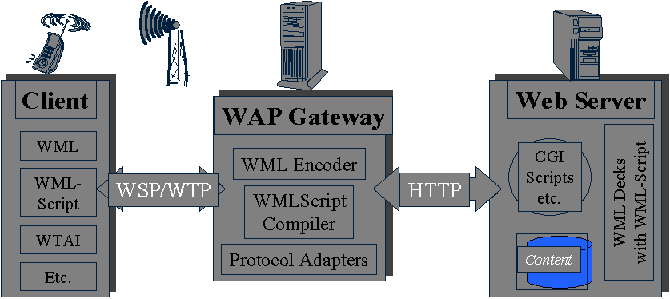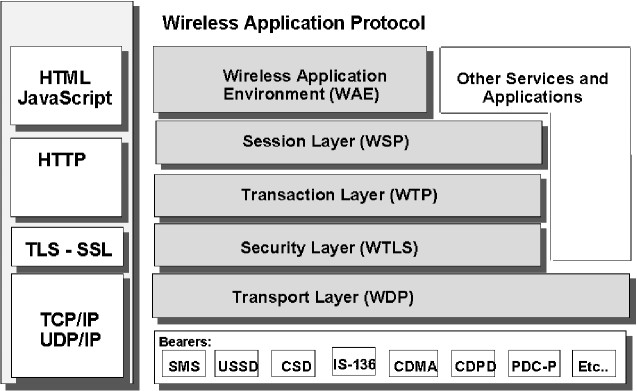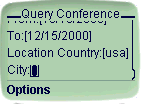Wireless access to a content routing system
Junbiao Zhang
C&C Research Laboratories, NEC USA Inc.
4 Independence Way
Princeton,NJ 08540
+1 609 951 2910
junzhang@nec-lab.com
Remo Strotkamp
C&C Research Laboratories, NEC USA Inc.
4 Independence Way
Princeton,NJ 08540
+1 609 951 2922
remo@nec-lab.com
ABSTRACT
We present in this paper our experience in providing a wireless access
interface to a distributed content search and delivery
system. Important Wireless Application Protocol (WAP) gateway
functions, in particular the Push function, are integrated into the
access points of the system. Wireless devices can use this interface
to search for distributed information and get notified of relevant new
content. A prototype implementation of the integration has been
completed which works successfully with WAP 1.2 compliant clients.
Keywords
WAP gateway, Push, Kannel, ANSWER system, content routing
1. INTRODUCTION
The Wireless Application Protocol (WAP) is a suite of protocol solutions
for providing web content to wireless devices. It enables wireless
devices with small screen sizes and slow, lossy communication channels
to access web content in a more efficient and natural way.
In this paper, we describe our experience in integrating the WAP
framework into the ANSWER information
system[1]. ANSWER is a
distributed content search and distribution system which provides
an infrastructure directly connecting information providers and
consumers. A symmetrical interaction model allows users to directly
search for results or get notified by the system through content
distribution based on prior interest indication. The core of the
system serves as a distributed information base and search engine which
can be built upon either an active network or an overlay application layer
network. On the edge (access points) of the system, a consistent
interface is provided for both content provision and search result
delivery through the use of XML[2]. For search users, both web access and
WAP access are provided for submission of queries as well as display
of search results and new content alerts. In order to allow for
wireless access, WAP gateway functions are introduced into the ANSWER
system. In particular,
the push feature of WAP is used as a natural means to distribute new
content to interested clients. We discuss in the rest of the paper how
we build the most essential gateway functions into the
ANSWER system and show through examples how wireless devices
interact with the system through the WAP interface.
2. ANSWER: core and edge
Due to space constraint, we shall only give a very brief overview of
the ANSWER architecture. Interested readers can refer to
[3] for a detailed description of the system.
 |
Figure 1: The ANSWER system |
ANSWER is built upon
a concept referred to as ``information routing'' and a symmetrical
interaction model between information providers and consumers.
In short, ``information routing'' is an
extension to the traditional network routing functions with
information discovery mechanisms. An ``information routing'' capable
network thus can route not only packets with specific destination addresses
but those that only contain the specifications of their
interests. Two types of information routing can be
distinguished. In the first type, packets searching for particular areas
of information
are routed to the relevant information providers. This is referred to
as query routing. In the second type, packets containing certain
information
are distributed to their targeted audience, or interested information
consumers. This is referred to as distribution routing.
The ANSWER system supports both query routing and distribution
routing which are realized in a cooperative and symmetrical way. These
are reflected in the way that the content providers
and the information consumers interact with each other. Both parties
may choose to inject active packets containing content descriptions or
information requests into the active network. Information routing
then serves as the bridge to matching entities. For convenience, we
shall refer to the entity providing content information as the
``feeder'' and the one injecting requests as the ``seeker''. Thus
query routing in ANSWER is responsible for routing ``seeker''
packets based on the ``feeder'' information in the system. Similarly,
``feeder'' packets are directed through distribution routing using the
interest traces left by the ``seeker'' packets.
For
efficient information storage and distribution in the network, only
indexing information, instead of whole application data sets is stored
in the network and such information is properly distilled (merge) when
necessary. This makes the ANSWER system architecture highly
scalable. A wide spectrum of applications ranging from e-commerce
transactions to software distributions can be supported by the ANSWER
system and new applications can be easily added into the system. Such
a flexibility is made possible by several factors:
- An ontology based hierarchical semantic structure for content
management[6].
- A dynamically constructed routing tree for directory information
distribution.
- Content routing modules at each ANSWER node for directory
management and packet forwarding.
- Intelligent agents in the packets for customized application
routing.
On the edge of the system, XML is used as a uniform interface for
content specification. Through the use of DTDs
and XSL[5] files, content data with application specific syntax and
semantics are converted into directory indices for distribution. These indices are eventually
propagated into the ANSWER core through periodic routing
information exchange among the ANSWER nodes. For the end users,
ANSWER edge nodes provide interfaces for both web browsers and WAP
enabled wireless devices. These interface modules are implemented as
Java Servlets. User queries are transformed into ANSWER format through JavaScript or WMLScript.
They are then injected into the ANSWER system and aggregated
into query indices for distribution into the ANSWER core. These
indices serve as indication of user interests which are used to direct
content packets. Search results, when routed to the edge nodes, are
converted into HTML or WML format using application
specific XSL files.
3. The Wireless Application Protocol
The Wireless Application Protocol (WAP) is a suite of protocol solutions
for providing web content to wireless devices.
 |
Figure 2: The WAP operation model |
Figure 2 shows the WAP operation model. As we can see from
the figure, the gateway serves as an important intermediary between
the wireless devices and the web servers. As we explained earlier, the
Internet oriented protocols are not optimized for wireless accesses
primarily due to the low bandwidth and high loss rate nature of the
wireless channels. Further, the limited screen sizes of the most
mobile wireless devices prohibit the proper display of full featured
HTML pages. Other limitations of the wireless devices such as small
memories and slow CPUs also dictate that wireless devices do not have
enough power for sophisticated processing. It is thus necessary for
the WAP gateway to provide
support for protocol bridging and content conversion(such as
compiling WML pages into byte code). To understand
the discrepancy of the WAP and the web protocol stacks and the gateway
functionalities, we compare the WAP hierarchy and the web protocol layers
in Figure 3. The current web is built upon the
Internet infrastructure with IP as the unified network layer
protocol. On top of IP, transport layer protocols such as TCP
(Transport Control Protocol) and UDP (User Datagram Protocol)
provide end to end connectivities between transport entities. Using
the reliability guaranteed by TCP/IP, the HTTP (HyperText Transport
Protocol) protocol defines the interactions between web browsers and
web servers in exchanging information. Finally, the application
layer content format is predominantly HTML with Java/JavaScript.
 |
Figure 3: The WAP protocol stack |
Due to the reasons we explained earlier, WAP adopted a different
protocol stack. On the top of the stack, the application layer
consists of the Wireless Application Environment (WAE). This includes
the Wireless Markup Language (WML), the JavaScript like WAP scripting
language WMLScript and the Wireless Telephony Architecture (WTA)
support. The session layer replaces HTTP with the Wireless Session
Protocol (WSP) which uses binary headers and has enhanced capability
negotiation mechanisms. The reliability provided by TCP in the Internet is now
guaranteed through the Wireless Transaction Protocol (WTP) while the
datagram support is provided by the Wireless Datagram Protocol
(WDP). WDP provides a unified layer in the WAP stack for various
physical layer bearer services such as GSM, CDMA and CDPD.
4. Wireless access to ANSWER
In order to support wireless access to the ANSWER system, we
extended the ANSWER edge nodes with functions which enable a
smooth and efficient WAP interface. These include:
- Identification of wireless devices
- Integration of WAP gateway functions
- Conversion and organization of search results
- Delivery of new content through WAP Push[4]
While the first function involves nothing more than checking the
related HTTP headers about the WAP agents, the other functions are
worth some extra explanations.
4.1 WAP gateway integration
Since the ANSWER edge nodes have a web interface, it is possible
to use an arbitrary WAP gateway to access the ANSWER
system. However, given the simple functions that wireless devices
perform to interact with the ANSWER system, it is unnecessary to have a
full featured WAP gateway. Further, directly integrating some of the WAP
gateway functions into the ANSWER edge nodes makes the wireless
accesses more efficient, as search requests and content deliveries do
not have to go through some centralized gateways which could become
system bottlenecks. As an example to these arguments, consider the
WAP Push feature and its use in the ANSWER system which we will
elaborate in a later section. It is the most
important feature for our system since it serves as a means to deliver new
content to interested users. However, if we rely on a
Push gateway to notify users each time there is new result available
at an edge node, the gateway will be flooded with PAP (Push Access
Protocol) requests. If instead we build the Push gateway function in
the edge nodes, not only can the bottleneck problem be alleviated, but
the PAP protocol can be eliminated all together. This is because each
edge node is the only source of Push requests for its gateway and thus
there is no longer the need for external protocol interactions. For
our purpose, we used the open source Kannel WAP gateway package as the
reference. Since Kannel was implemented in C and did not support the
Push function, our integration effort involved both re-implementing
features in Java and building the gateway functions.
4.2 Search result conversion
As we mentioned earlier, the query results from the ANSWER
system are coded in XML format for easy conversion into different display
languages using XSL. For WAP devices, results are converted into WML
cards where each result item corresponds naturally to a single card.
Given the distributed nature of the ANSWER system, the results
of a search are delivered to the user progressively as content
summaries from different parts of the system become available. With
the help of the edge nodes, the whole result sets can be displayed
properly by the wireless devices. The edge node groups the results as
they become available. Based on certain threshold(e.g. time passed or
number of results available), it delivers the initial set of results
as a deck of cards to the wireless device. The last card in the deck
would ask the user whether he/she wants to see more results. More
new decks from the edge node will then be fetched if the user decides
to continue. Otherwise, the temporary storage of the result set is
erased from the edge node.
4.3 New content delivery
One of the distinctive features of the ANSWER system is the
symmetrical interaction model between content providers and
consumers. That is, not only can query packets be routed to the proper
content destinations, but content packets can be delivered to users
who expressed their interests before. New content notification is thus
an integral part of the wireless access. From WAP 1.2 and higher, a
Push function is specified. It allows a user to send information
asynchronously to a WAP enabled device. To do so, the user sends a
request containing the id of the intended device to a Push
gateway. The gateway then locate the device and deliver the
message. With this push feature, we can very smoothly deliver new
content notifications to WAP users. As a very important part of our
WAP integration, we have implemented the Push gateway functions in the
ANSWER edge nodes. When a WAP device submits an ANSWER
query to an edge node, its device id together with the query id are
stored at the node. When new results are available at a later
stage(after certain time threshold), if the query has not been
canceled by the user, the results are converted into a WML deck, a
Push message containing a link to the deck is then sent to the
device. Such a message will be either delivered as an alert or put in
the user's mail box.
5. Examples
One of the applications we
developed on the ANSWER framework is the conference announcement and
search application. Conference organizers can announce the conferences using a special
XML format. A user can search for specific conferences through a web
browser or a WAP device based on different criteria. See Figure 4 for
the WAP query interface. The corresponding WML file and WMLScript
are downloaded from a web server, in our case Apache, through the kannel WAP
gateway. The query data entered by the user is analyzed and reformatted by the WMLScript
and sent back to a servlet. This servlet packs the data into an ANSWER
query packet and injects it into the ANSWER network. It also returns a WML
page containing a timer to the WAP device. The results returned from the
ANSWER network are aggregated by the servlet into a deck of cards, with
each card representing one conference. The WAP device, upon the
expiration of the timer, retrieves the results currently available at the
servlet and displays them as shown in Figure 5. Again this transaction goes
through the WAP gateway.
 | |  |
| Figure 4: Entering a query | | Figure 5: Results obtained |
Users may also be notified of relevant new announcements through alert messages
on the WAP devices. The last card of the returned results from a query
allows the user to subscribe to the announcement feature. Figure 6 shows the
announcement subscription card. If the user subscribes to this service, a
special flag will be set at the servlet for the user. Once the servlet receives
additional replies to the original query, it will compile a Push Message and
send it to the WAP device. The message contains a link to where the new
result can be retrieved. It is compiled into byte code and sent directly to the
WAP device through the Push gateway which is part of the servlet. Figure
7 shows the screen shot of a WAP phone when a new result becomes
available and the user chooses to view the result. Since we are not aware of
any Push capable WAP phones, the WAP phone in this example is a
simulator in the Nokia WAP Toolkit.
 | |  |
| Figure 6: Receive updates? | | Figure 7: New results arrived |
6. Status and future work
We have finished integrating the basic WAP gateway functions into the
ANSWER system. A prototype system which uses the ANSWER
framework has been tested with both WAP phones and WAP simulation
softwares. We are investigating various aspects of mobility
management for wireless access in the ANSWER system. In
particular, we plan to integrate support in the ANSWER system so
that 1) mobile devices can locate the ``nearest'' edge nodes, and 2)
user sessions can remain uninterrupted, e.g. search results can still
be properly delivered even when the user moves or temporarily
disconnects from the ANSWER system.
7. REFERENCES
- WAP Forum. Wireless Application Protocol Architecture Specification.
http://www1.wapforum.org/tech/terms.asp?doc=WAP-100-WAPArch-19980430-a.pdf.
- J. Zhang and M. Ott. ANSWER: Information Routing Based on Active Networks.
The 5th Asia Pacific Conference on Communications. Beijing, China. October 1999.
- W3C. Extensible Markup Language(XML) 1.0.
http://www.w3.org/TR/1998/REC-xml-19980210.html.
- WAP Forum. Push Architectural Overview.
http://www1.wapforum.org/tech/terms.asp?doc=WAP-165-PushArchOverview-19991108-a.pdf.
- W3C. Extensible Stylesheet Language(XSL) 1.0.
http://www.w3.org/TR/xsl/.
- T.R. Gruber. Toward principles for the design of ontologies used for knowledge sharing.
Padova workshop on Formal Ontology, March 1993.







